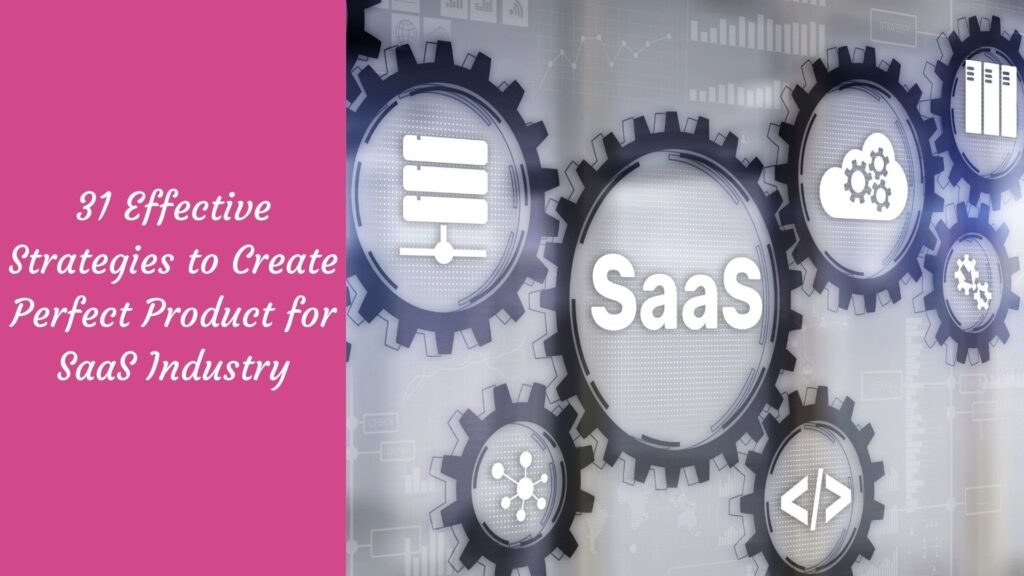Get ready for a game-changing era in the tech industry – 2024 is just around the corner!
Innovations and advancements are set to sweep through the world at an unprecedented pace.
Whether you’re a product team, SaaS enthusiast, developer, or IT-minded individual, staying ahead of the curve is crucial.
Buckle up as we dive into this blog post, where we’ll uncover 31 steps to craft the perfect product experience in 2024. By the end, you’ll be armed with the knowledge to create an outstanding user experience that will leave a lasting impression. Let’s go!
What developments have occurred in the SaaS industry in 2024?

- Rise of AI: The integration of AI and Machine Learning in SaaS products will become ubiquitous in 2024. It has enabled companies to offer more personalized experiences, predictive analytics, and automate repetitive tasks.
- Increase in Cybersecurity Measures: With the increase in remote work and cloud-based solutions, companies have invested heavily in robust security measures to protect sensitive data.
- Adoption of Voice Technology: Many SaaS tools have successfully incorporated voice technology into their platforms, making it easier for users to interact with the software.
- Growth of Micro SaaS: There has been a surge in Micro SaaS, smaller software solutions developed by small teams or even individuals, targeting niche problems.
- Advancements in Integrations and API: More SaaS companies have improved their APIs and integrations, making their software easily connectable with other tools enhancing user experience.
- Emphasis on User Experience: The SaaS industry in 2024 places a significant focus on user experience, ensuring seamless navigation, intuitive design, and user-friendly interfaces.
- Expansion of Mobile SaaS: The development of mobile applications for SaaS products has grown tremendously, providing users with the convenience of accessing their tools from anywhere.
- Emergence of Green SaaS: With the rise in environmental consciousness, there has been an emergence of Green SaaS software companies that are making efforts to reduce their carbon footprint.
- Shift to Usage-Based Pricing: Many SaaS companies have moved towards usage-based pricing, giving customers more flexibility and control over their expenses.
31 Effective Strategies to Create a Perfect Product for the SaaS Industry

Here are the 31 strategies that can help create a Perfect product for the SaaS industry:
Research is Key
Before you start developing your Perfect Product, it’s crucial to identify and research your target audience. Gathering insights through surveys, interviews, and focus groups can provide valuable information about your users’ needs, preferences, and pain points. Understanding your audience is essential for successful product development.
Create User Personas
User personas help you identify the needs of your potential users in a specific group, giving you a better understanding of their behaviors and decision-making process. With this information, you can develop tailored experiences that cater to their preferences.
Define Your User Journey
The user journey provides an overview of the different stages users go through to achieve their goals when using your product. By mapping out this journey, you can identify places where you can enhance the user experience.
Design for Mobile First
With the rise of smartphone usage, it’s essential to design your perfect product with the mobile-first approach in mind. This approach allows you to focus on the essential elements that matter to your users, providing a seamless experience across all platforms.
Simplify Your User Interface
A streamlined user interface (UI) helps users navigate through your product with ease. Using a clear, uncluttered, and intuitive interface that includes standardized icons and buttons can go a long way in enhancing the user experience.
Incorporate Emotional Design
Incorporating emotions into your perfect product design can help users connect with your brand, promoting a long-lasting relationship. Consider the emotional impact of using your product and how it can contribute to enhancing the user experience.
Personalized Experiences
Personalization is critical in creating a unique experience for your users, tailored to their individual needs. By using data analytics and user feedback, you can implement customized features and content that cater to varying user preferences.
Accessibility for Everyone
Accessible design enables all users, regardless of their abilities, to use your product. Meet the Web Content Accessibility Guidelines 2.1 standards for developing accessible products.
Select the Right Technology
Selecting the right technology for your product can be the difference between a seamless experience and a frustrating one. Consider factors such as scalability, integration capabilities, utility, reliability, and security when choosing technology.
Create a Cohesive Brand
A consistent brand identity helps you create a cohesive experience for your users. Use recognizable brand voice, tone, and visual elements throughout your product to enhance your brand’s impact and establish long-lasting relationships with your users.
Use Micro-interactions
Micro-interactions can add a layer of interaction that helps users navigate through your product quickly. Use micro-interactions in the form of animations, haptic feedback, and visual effects implemented naturally throughout your product’s user interface in a non-intrusive manner.
Content Design
Content is an important component of your perfect product experience and can significantly impact the user’s perception of your product. Use clear, concise, and intuitive language in the form of guides, tooltips, and tutorials to make it easy for your users to understand how your product works.
Use Machine Learning
Machine learning integrates artificial intelligence into your perfect product to provide an intelligent experience for users. Use machine learning techniques to provide relevant, personalized content and recommendations.
Use Contextual Help
Contextual help offers additional information and assistance to users in a specific context. Integrating contextual help in the form of tooltips, pop-ups, and suggestions can significantly enhance the user experience.
Navigation Design
Navigation design provides a guide to help users move through your product seamlessly. Use clear and concise menus, breadcrumbs, and sections to provide a smooth navigation process.
Gamify Your Product
Gamification can significantly enhance the user experience by making it more engaging and fun. Use game mechanics such as points, challenges, leaderboards, and badges to create a sense of achievement and promote user loyalty.
Seamless Onboarding
Onboarding is a critical component in introducing users to your product. Use a simple, interactive, and intuitive process that highlights the benefits of your product, identifying the user’s goals and setting expectations.
Make Data-Driven Decisions
Data analytics can provide important insights into user behavior and usage patterns. Use this information to make informed decisions that improve the user experience & meet their expectations.
Test Early and Often
Testing your product early and often can provide meaningful feedback that helps improve the user experience. Use user testing, A/B testing, and usability testing to identify problems and opportunities to enhance your product.
Continuously Iterate
Iterating your design and functionality is necessary to keep your product up to date. Continuously receive feedback from your users and implement improvements to provide a better user experience.
Responsive Design
A responsive design ensures that your product is optimized for different screen sizes and resolutions. This design approach ensures that users must have an optimal experience, regardless of the device they use.
Use Natural Language Processing
Natural language processing integrates machine learning and human language to provide natural interactions with your product. Use voice and text recognition to enable users to interact with your product in a natural language format.
Create Interactive Visualizations
Interactive visualizations provide an engaging means to interpret data analytics, providing users with an intuitive understanding of complex information.
Use Persuasive Design
The persuasive design integrates behavioral economics to influence users’ actions and decisions. Use persuasive design techniques to enhance user engagement, loyalty, and satisfaction.
Use High-Resolution Images
High-resolution images provide users with an aesthetic and visually appealing experience. Use high-quality images throughout your product to enhance its appeal and the user experience.
Consider Security and Privacy
Security and privacy are critical concerns for users of any product. Ensure that your product meets standard data protection regulations and implements standard security protocols to protect users’ information.
Use Scalable Architecture
Use a scalable architecture that can accommodate increased traffic and data usage, ensuring your product remains reliable and responsive.
Use APIs
APIs integrate different systems and functionalities to provide a seamless user experience. Implement APIs to provide users with relevant information, features, and functionality.
Use Progressive Web Apps
Progressive web apps (PWAs) combine the benefits of website & mobile app, providing users with an app-like experience from a website. Use PWAs to provide an app-like experience without having to download or install an app.
Use Social Authentication
Social authentication enables users to sign in to your product using their social media accounts. This authentication method provides a seamless and convenient login process for users.
Provide Continual Support
Provide continual support for your users by providing quick and efficient customer support. Implement customer support systems that provide 24/7 assistance and are easy to use.
FAQs
What trends in product design should I be aware of?
Some trends in product design that you should be aware of include:
1. Minimalism: Clean and simple designs that focus on essential elements.
2. Sustainability: Eco-friendly materials and designs that reduce environmental impact.
3. User-Centric Design: Putting the user at the center of the design process to create intuitive and user-friendly products.
4. Mobile-First Design: Designing products with mobile devices in mind, considering responsive and adaptive layouts.
5. Personalization: Customizable products that cater to individual preferences and needs.
6. Immersive Experiences: Incorporating virtual reality (VR) and augmented reality (AR) to create engaging and interactive user experiences.
These are just a few trends, and the field of product design is constantly evolving. It’s essential to stay updated and adapt to the ever-changing landscape.
What technologies will shape the product experience in 2024?
In 2024, several technologies are expected to shape the product experience. AI will continue to advance, enhancing personalization and automation. Internet of Things (IoT) devices will become more prevalent, seamlessly connecting various products and creating an intelligent ecosystem. Augmented reality and virtual reality will further immerse users in interactive and immersive experiences.
Additionally, advancements in 5G technology will enable faster and more reliable connectivity, unlocking new possibilities for product innovation. Overall, these technologies will revolutionize the way we interact with products and redefine the future of user experience.
What strategies can I use to design an immersive user experience?
We can work together to design an immersive user experience by focusing on a few key strategies:
- Let’s put ourselves in the user’s shoes and think about their needs and desires.
- We can create engaging and intuitive interfaces that are easy to navigate.
- We should prioritize feedback and iterate based on user input.
With our collaborative effort, we can create an experience that truly captivates and delights users!
What methods should I use to measure and optimize the product experience?
To measure and optimize the product experience, a combination of both quantitative & qualitative methods can be used.
Quantitative methods, such as A/B testing, analytics tracking, and user surveys, provide statistical insights into user behavior and satisfaction. These metrics can reveal patterns and trends that can inform optimization strategies.
On the other hand, qualitative methods such as user interviews, usability testing, and case studies provide deeper insights into user needs, motivations, and pain points. These insights can help you understand why users behave the way they do and how to improve the product to meet their needs better.
Furthermore, consistent iteration based on these insights, followed by further measuring and testing, is crucial to refine and enhance the user experience continuously.
How can I use AI and machine learning to enhance the product experience?
AI and Machine Learning can vastly enhance the product experience by adding a layer of personalization and predictive behavior.
Together, we can integrate AI into our product to analyze user behavior and preferences, allowing us to tailor the user journey. Machine Learning algorithms could help us predict user needs even before they express them, proactively offering solutions and recommendations.
Additionally, AI can automate specific tasks, improving efficiency and speed for users. Remember, the key is to use AI and Machine Learning to add value without making the product overly complex or difficult to use.
How can I ensure my product design strategy is future-proof and sustainable?
Ensuring your product design strategy is future-proof and sustainable requires a proactive approach that factors in evolving technologies, user habits, and environmental considerations. Staying abreast of technological advancements and trends can help align the product’s design with future expectations.
Similarly, understanding shifting user behaviors can guide the creation of designs that evolve with these changes. Sustainability in product design involves considering the product’s entire lifecycle, from the sourcing of materials to energy use to end-of-life disposal. It requires a commitment to reducing environmental impact and a willingness to innovate in terms of materials and processes.
Furthermore, always employing a user-centered design approach guarantees that the product remains relevant and desirable to users, which is another vital aspect of future-proofing. Lastly, flexibility is critical. A future-proof and sustainable design strategy is never set in stone—it adapts and evolves, just like the world around it.
How can I make sure my product design remains user-centric?
- Understand your users: Start by developing a deep understanding of your target users. It could involve user research, interviews, or surveys to gain insights into their needs, preferences, and behaviors.
- Involve users in the design process: When possible, involve users in the design process through methods like participatory design or co-design. It ensures the product is built for the users, not just for them.
- Regular user testing: Conduct regular user testing sessions throughout the product development process. It helps identify any issues or improvements from the user’s perspective.
- Iterate based on feedback: Use the feedback from user testing to make iterative improvements to the product design. Remember, the design process is continuous and should evolve based on user feedback.
- Emphasize usability over aesthetics: While pleasing aesthetics are important, focus on usability first. The product should be easy to use and intuitive, meeting the user’s needs effectively.
- Accessibility is critical: Ensure your product is accessible to all potential users, including those with disabilities. It not only broadens your user base but also ensures inclusivity in your design.
- Keep up with user trends and behaviors: User needs and behaviors are not static. They evolve, so it’s essential to keep up with these changes and adapt your design accordingly.
What approaches can I use to ensure a consistent product experience across devices?
To ensure a consistent product experience across various devices, you should adopt a responsive design strategy. This approach ensures that your product’s interface and content automatically adjust to fit any screen size, whether it’s a desktop, laptop, tablet, or smartphone.
Additionally, consider utilizing a design system – a collection of reusable components and standards.
This system can guide the development process and ensure consistency across different parts of the product. Regular testing on different devices and under diverse conditions is also crucial to ensure consistency and uncover any device-specific issues.
Furthermore, aim for feature parity across devices, meaning that users should be able to perform the same tasks with comparable ease regardless of the device they are using.
Finally, don’t forget to consider the loading times and performance on lower-end devices to ensure you’re providing an equitable experience to all users.
Conclusion
Providing the perfect product experience in 2024 requires a comprehensive understanding of users’ needs and preferences, coupled with functional design and advanced technology.
By following the 31 steps outlined above, you can create a seamless, engaging, and effective product experience that meets user expectations, providing a solid foundation for your brand growth and success.

